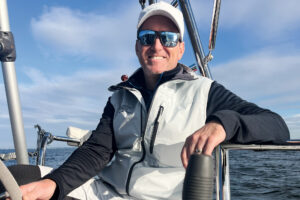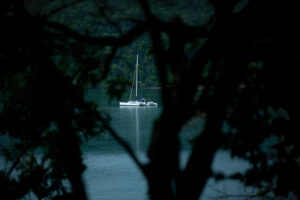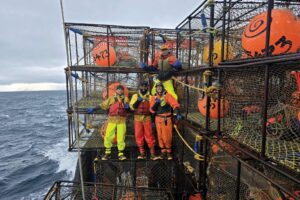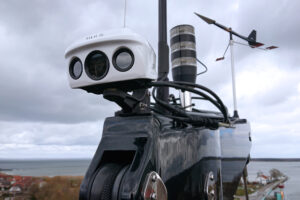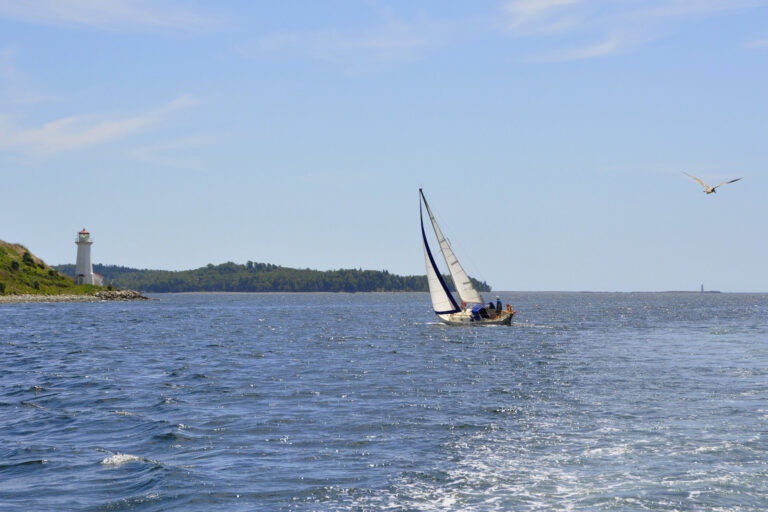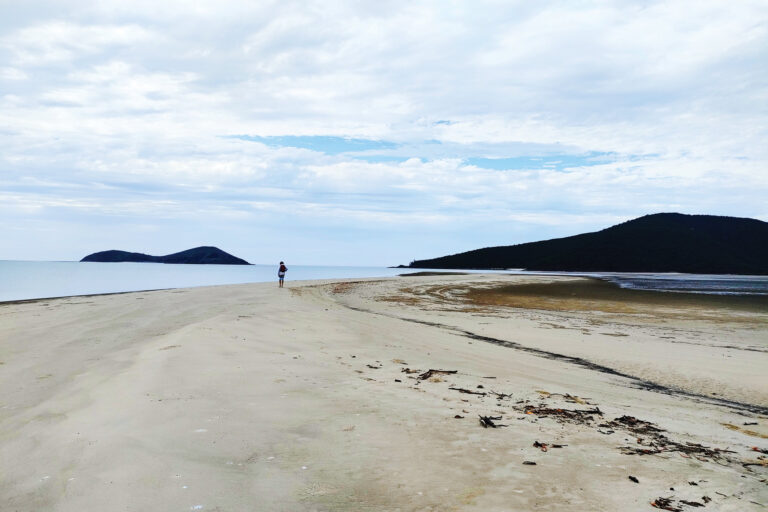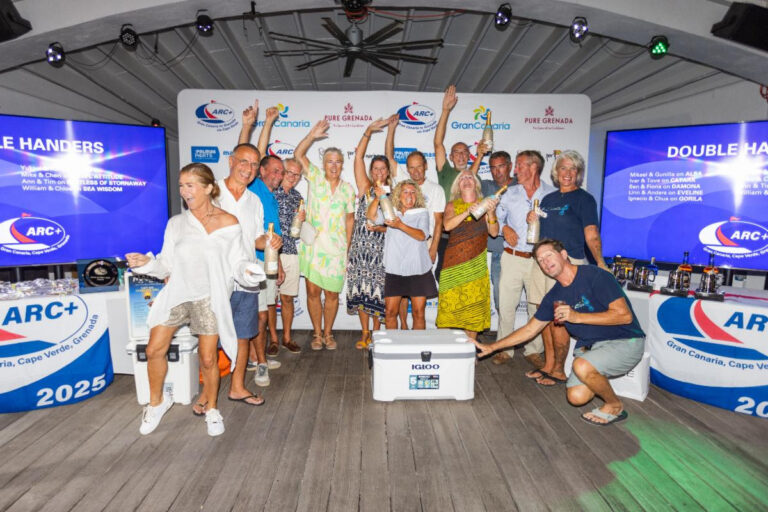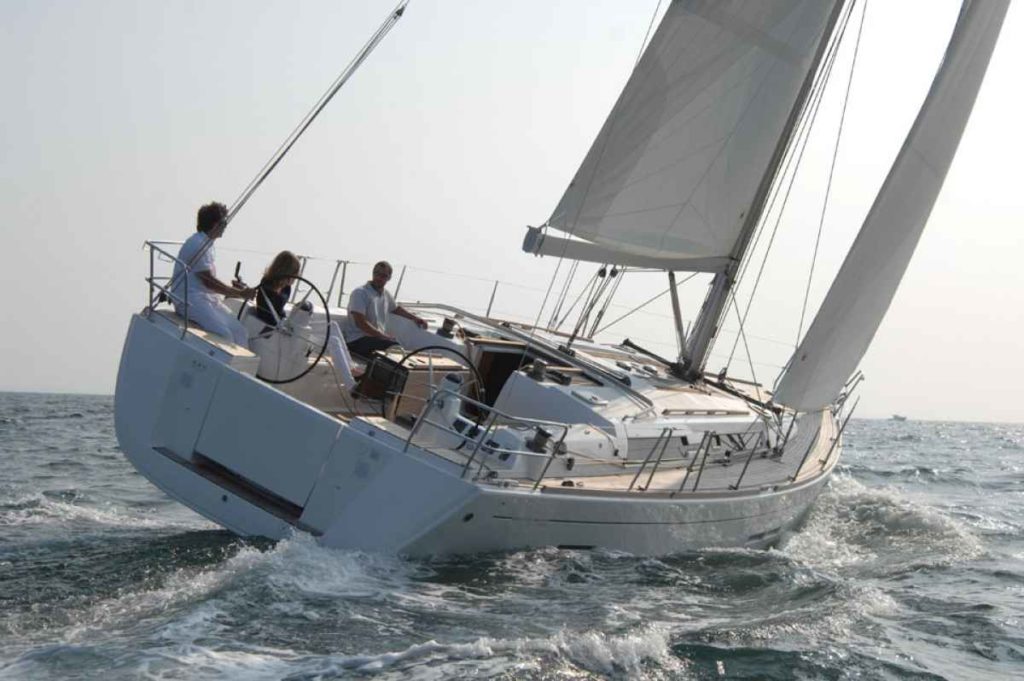
It was a snarly Chesapeake Bay morning, and though the rain hadn’t yet arrived, an easterly wind gusting past 20 knots had kicked up enough chop to send spray flying across the military-sized Zodiac carrying yours truly and CW‘s Boat of the Year judges to our sea trial aboard the Dufour Grand’ Large 445. The boat had just days earlier made its North American debut at the U.S. Sailboat Show in Annapolis, Maryland, and we were all keen to see how this latest model from the upscale French builder would perform out where it belonged, on the water, with a good breeze filling the sails.
The Dufour 445 replaces the 455 in the company’s range of cruising sailboats, and it’s the latest model to join the fleet from Italian yacht designer Umberto Felci and the Dufour Yachts Design Team. As we approached the boat, which was motorsailing leisurely along the far shore under main alone, we saw that the sloop had a definitely elegant Euro styling: a white hull; a wide fold-down swim platform across the transom; twin wheels; teak accents on deck and on cockpit seats; a white, low-slung cabin house that tapered into the deck just forward of the mast; a plumb bow and an optional retracting sprit for the colored sails that you’d want to fly when sailing off the wind.
Five of us clamored aboard and into the cockpit to join Eric Macklin, Dufour’s U.S. representative. Though there was plenty of room to move about, I immediately found a seat under the generously sized dodger and let the judges go about their business. First off, they killed the engine and rolled out two-thirds of the genoa, set on a Facnor furler. Next, BOTY judge Beth Leonard went to work and used the single-line reefing system to put the first tuck in the main, set on a Z-Spar rig with double swept-back spreaders, so the sail plan would match the blustery conditions. With the 445 sailing closehauled, boat speed in knots hovered in the high 7s and low 8s as the wind wavered in the high teens. Bearing off to a reach, the speedo crept into the mid-8-knot range and remained there as we cut smoothly through the waves. Later, at the helm, I found that the Lewmar steering and twin wheels provided ample feedback and fingertip control of the boat.
While the judges trimmed and tweaked, a trip below rewarded me with a smooth ride standing in the saloon roughly amidships. Even on this gray day, the eight deck hatches and eight ports let in plenty of light that played off the white upholstery and counter tops, brightening the dark-colored moabi mahogany paneling and trim and the laminated moabi floorboards.

The 445 comes in three- and four-cabin configurations; the latter sports twin cabins in the bow. In each, two aft cabins feature queen berths and hanging lockers; the cabin to port has direct access to the head and shower located at the base of the companionway. This head also has a self-draining hanging locker for wet foulies. In the saloon, a U-shaped seat surrounds the large dining table, and a centerline bench with storage under adds to the seating possibilities. Dufour has tucked a second refrigerator under the aft portion of the U. To starboard, a large top-loading fridge (with a front-opening door, to boot) sits just forward of the full-size, forward-facing nav station. The Isotherm fridge’s top provides lots of counter space to augment the inline galley that runs forward to the main bulkhead and includes stove and oven, a double stainless-steel sink, ample drawers, and lots of cabinet space. More storage—including a built-in wine rack—is found beneath the sole.
The boat we sailed was the three-cabin model. Forward, there’s a centerline queen berth in the almost overly spacious owners cabin, with a head to starboard and a voluminous shower to port. The judges wondered if it would be possible to combine head and shower to one side and turn the latter’s space into a small office. Production considerations, however, preclude such customization, said Macklin.

Moving about the saloon, I found ample handholds thanks to rails built in to either side of the cabin top. A shorter sailor, though, might find them out of reach and the interior volume a little daunting when navigating forward on a heel.
Topside, wide side decks made it easy to move fore and aft. Handrails on the low-profile cabin top were hard to reach, but when the boat was heeled, the lifelines provided something solid to grasp. On every boat he tests, BOTY judge Alvah Simon performs a unique dash from the forepeak, through the cabin, up the companionway, and to the bow pulpit. He pronounced handholds and footing on the 445 to be adequate after running his route.
Fellow judge Ed Sherman also deemed the installation of electronics and other systems as acceptable.
Dufour uses a structural grid that’s bonded to the hand-laid glass hull to distribute keel and rig loads. The foam-cored deck is injection molded, which saves weight and produces a finished interior surface. It’s bonded to the hull’s flange using 3M’s 5200 and mechanically fastened every 8 inches. The cast-iron keel comes in either a deep, 7-foot-3-inch version or a shoal-draft, 5-foot-10-inch configuration.
Under power, the 75-horsepower Volvo diesel and saildrive pushed us along at about 6 knots in cruising mode (2,000 rpm) and just over 8 knots when wide open. The semi-elliptical rudder provided firm control in both forward and reverse. Belowdecks, engine noise was quite tolerable, as we’ve come to expect from boats that aren’t shaft-driven.
From its easy-to-handle, conventional, slab-reefed main and roller-furler headsail to its practical and attractive deck layout to the comforts below, the Dufour 445 offers a lively platform for the sailor who wants to turn heads at the dock and click off the miles while under way.
LOA 44′ 3″ (13.49 m.)
LWL 39′ 1″ (11.91 m.)
Beam 14′ 3″ (4.34 m.)
Draft (deep/shoal) 7′ 3″/5′ 10″ (2.21/1.78 m.)
Sail Area (100%) 802 sq. ft. (74.5 sq. m.)
Ballast 6,724 lb. (3,050 kg.)
Displacement 22,770 lb. (10,328 kg.)
Ballast/D .30
D/L 170
SA/D 16.0
Water 125 gal. (473 l.)
Fuel 66 gal. (250 l.)
Holding 26 gal. (98 l.)
Mast Height 60′ 4″ (18.39 m.)
Engine 75-hp. Volvo with saildrive (55-hp. is standard)
Designer Umberto Felci and the Dufour Yachts Design Team
Price $325,000
Dufour Yachts
(352) 871-0362
www.dufour-yachts.com

